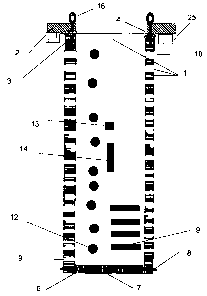Some of the information on this Web page has been provided by external sources. The Government of Canada is not responsible for the accuracy, reliability or currency of the information supplied by external sources. Users wishing to rely upon this information should consult directly with the source of the information. Content provided by external sources is not subject to official languages, privacy and accessibility requirements.
Any discrepancies in the text and image of the Claims and Abstract are due to differing posting times. Text of the Claims and Abstract are posted:
| (12) Patent Application: | (11) CA 2530729 |
|---|---|
| (54) English Title: | BARREL DEBRIS TRAP |
| (54) French Title: | GRILLE A DEBRIS EN TAMBOUR |
| Status: | Deemed Abandoned and Beyond the Period of Reinstatement - Pending Response to Notice of Disregarded Communication |
| (51) International Patent Classification (IPC): |
|
|---|---|
| (72) Inventors : |
|
| (73) Owners : |
|
| (71) Applicants : |
|
| (74) Agent: | |
| (74) Associate agent: | |
| (45) Issued: | |
| (22) Filed Date: | 2005-12-28 |
| (41) Open to Public Inspection: | 2007-06-28 |
| Availability of licence: | N/A |
| Dedicated to the Public: | N/A |
| (25) Language of filing: | English |
| Patent Cooperation Treaty (PCT): | No |
|---|
| (30) Application Priority Data: | None |
|---|
A system of deep well barrel debris traps for storm water polishing before
discharge to
groundwater recharge wells is disclosed herein. The debris trap is formed by
one or more
traps, which can fill up relatively in sequence. The debris trap captures
coarse sediment
and leaves which enter into the well portion of wells and aquifer recharge
wells. The
traps are designed to capture debris and sediment such as leaves, gravel, and
other large
debris which would plug filters or aquifer formations. By building the traps
in series
these can capture the entire stream flow, each can fill up individually and
when full, can
continue to allow substantial flows of water past the individual trap. When
used in
conjunction with Storm Water Infiltration wells and aquifer recharge wells the
debris
trap can extent the time between maintenance cycles, increase the time to full
cake
formation plugging of filters or the aquifer formation.
Note: Claims are shown in the official language in which they were submitted.
Note: Descriptions are shown in the official language in which they were submitted.

2024-08-01:As part of the Next Generation Patents (NGP) transition, the Canadian Patents Database (CPD) now contains a more detailed Event History, which replicates the Event Log of our new back-office solution.
Please note that "Inactive:" events refers to events no longer in use in our new back-office solution.
For a clearer understanding of the status of the application/patent presented on this page, the site Disclaimer , as well as the definitions for Patent , Event History , Maintenance Fee and Payment History should be consulted.
| Description | Date |
|---|---|
| Application Not Reinstated by Deadline | 2010-12-29 |
| Time Limit for Reversal Expired | 2010-12-29 |
| Inactive: Adhoc Request Documented | 2010-09-30 |
| Deemed Abandoned - Failure to Respond to Maintenance Fee Notice | 2009-12-29 |
| Application Published (Open to Public Inspection) | 2007-06-28 |
| Inactive: Cover page published | 2007-06-27 |
| Inactive: IPC assigned | 2006-03-14 |
| Inactive: IPC assigned | 2006-03-14 |
| Inactive: First IPC assigned | 2006-03-14 |
| Inactive: IPC assigned | 2006-03-12 |
| Filing Requirements Determined Compliant | 2006-01-31 |
| Inactive: Office letter | 2006-01-31 |
| Inactive: Filing certificate - No RFE (English) | 2006-01-31 |
| Application Received - Regular National | 2006-01-31 |
| Small Entity Declaration Determined Compliant | 2005-12-28 |
| Abandonment Date | Reason | Reinstatement Date |
|---|---|---|
| 2009-12-29 |
The last payment was received on 2008-12-29
Note : If the full payment has not been received on or before the date indicated, a further fee may be required which may be one of the following
Please refer to the CIPO Patent Fees web page to see all current fee amounts.
| Fee Type | Anniversary Year | Due Date | Paid Date |
|---|---|---|---|
| Application fee - small | 2005-12-28 | ||
| MF (application, 2nd anniv.) - small | 02 | 2007-12-28 | 2007-12-19 |
| MF (application, 3rd anniv.) - small | 03 | 2008-12-29 | 2008-12-29 |
Note: Records showing the ownership history in alphabetical order.
| Current Owners on Record |
|---|
| JOHN VAN EGMOND |
| Past Owners on Record |
|---|
| None |